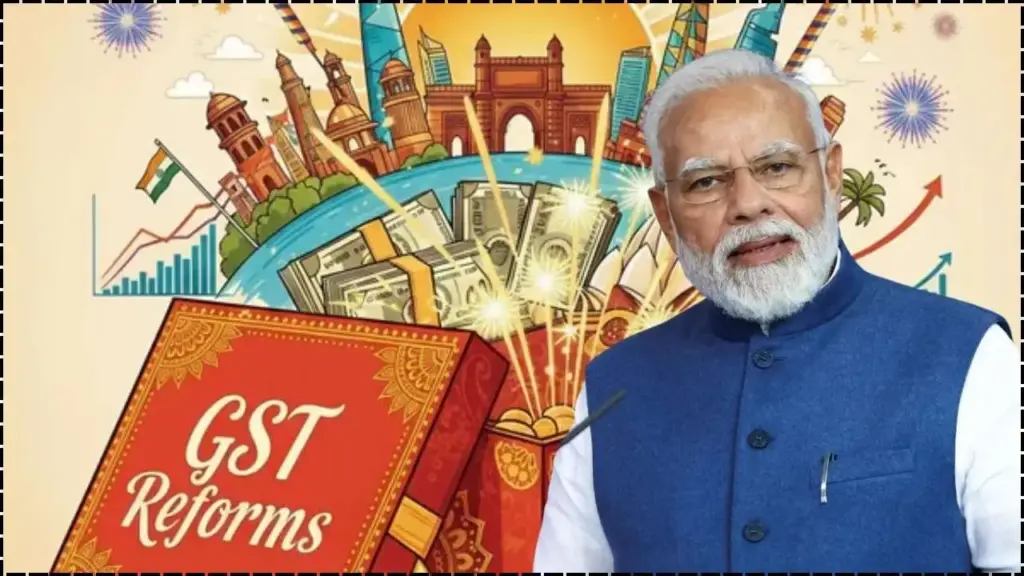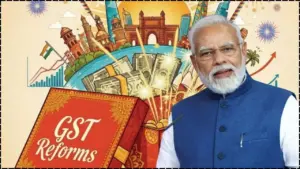In a significant move to ease the financial burden on consumers, the Indian government has implemented a reduction in Goods and Services Tax (GST) rates, leading to a decrease in fuel prices across the country. Effective from October 2025, this change has seen a reduction in the price of petrol, diesel, and CNG across the country. For many households and businesses, this reduction comes as a welcome relief, especially with rising fuel prices often being a major cause of concern.

Whether you’re a car owner, trucker, or just someone who depends on public transport, these changes have likely caught your attention. The lower fuel prices will have far-reaching effects, not just on your daily expenses, but on the broader economy. Let’s break down what these changes mean for you, how much you’ll save, and the real impact this will have.
Table of Contents
New GST Rate Slashes Fuel Prices
| Fuel Type | Previous Price (₹/L) | New Price (₹/L) | Price Drop (%) | Effective Date |
|---|---|---|---|---|
| Petrol | 103.50 | 100.00 | 3.4% | October 2025 |
| Diesel | 91.00 | 87.50 | 3.8% | October 2025 |
| CNG | 90.75 | 87.00 | 4.2% | October 2025 |
Note: These prices are average estimates, and local variations due to state taxes may apply.
The slashed fuel prices thanks to the new GST reforms have provided some much-needed relief for consumers and businesses alike. Whether you’re an everyday commuter or a business owner, these changes will likely make a noticeable impact on your expenses. With petrol, diesel, and CNG now cheaper, you’ll see immediate savings, and businesses that rely on transportation will have lower operational costs.
As we adapt to these changes, it’s a great opportunity to look into more fuel-efficient and environmentally friendly options for the future. So, the next time you fill up your car, truck, or CNG vehicle, remember: you’re getting a little more for your buck, and that’s something worth celebrating!
What’s Changing?
The Indian government has reduced the GST rate on petroleum products, which has directly resulted in lower fuel prices across India. This move is part of the ongoing efforts to simplify the tax structure under the GST reforms, which aim to benefit consumers, ease transportation costs, and promote economic growth.
The GST Change
Previously, fuel products like petrol, diesel, and CNG had higher tax slabs, contributing to their high prices. With the new GST rate slashing taxes on smaller vehicles, the prices of petrol and diesel have decreased by up to 3.8%. This reduction comes as a direct result of lower taxes, and it’s not just a one-time thing—it’s expected to remain stable, helping the long-term financial situation for consumers.
Why This Matters to You
1. Immediate Impact on Consumers
If you’ve been feeling the pinch every time you fill up your car or truck, this price drop is a big win. Imagine saving ₹3-5 per litre on your petrol or diesel bills. For a commuter or someone who uses a vehicle daily, that could amount to significant savings each month.
Example: If you drive a car that uses 50 liters of fuel per month, this reduction could save you anywhere between ₹150 to ₹250 per month, depending on your fuel type.
This drop in fuel prices has a ripple effect on your overall spending. With lower fuel costs, the price of goods and services that rely on transportation will likely become cheaper as well. This includes everything from food to consumer products, as businesses will pay less for transportation and, hopefully, pass those savings down to you.
2. Impact on Commercial Transportation
For truck drivers, logistics companies, and freight operations, the drop in fuel costs is a game changer. The reduction in diesel prices by ₹3.50 per liter could reduce operational costs significantly, especially for businesses that rely heavily on fuel. This can help improve profit margins, especially for small businesses.
Example: A logistics company using 1,000 liters of diesel per day could save around ₹3,500 per day with this change—significant savings in the long term.
How Much Are You Really Saving?
Let’s break it down with specific numbers. Here’s a closer look at how much you’ll save with the latest price reductions across petrol, diesel, and CNG.
Petrol:
- Previous Price: ₹103.50 per liter
- New Price: ₹100.00 per liter
- Savings: ₹3.50 per liter
Diesel:
- Previous Price: ₹91.00 per liter
- New Price: ₹87.50 per liter
- Savings: ₹3.50 per liter
CNG:
- Previous Price: ₹90.75 per kg
- New Price: ₹87.00 per kg
- Savings: ₹3.75 per kg
If you’re filling up a small sedan that uses 40 liters of fuel per month, you could save up to ₹140 per month. For those with larger vehicles or commercial fleets, the savings can be even more substantial.
Broader Impact: What This Means for the Economy
1. Relief for Small and Medium-Sized Enterprises (SMEs)
For small businesses and entrepreneurs who rely on transportation for their operations, this fuel price drop provides much-needed relief. The cost savings from lower fuel prices can help businesses cut down on operational expenses, allowing them to reinvest in their operations, hire more staff, or even offer better prices to customers.
2. Lower Transportation Costs
As fuel prices drop, transportation companies and delivery services will likely see reductions in their overheads. This can translate into cheaper goods transportation costs, making products more affordable for consumers. You might start to see cheaper delivery costs or lower prices on online orders as businesses pass on their savings.
3. Environmental Impact
Another indirect benefit of lower fuel prices could be a shift towards cleaner transportation. Although there’s always concern about environmental impact, cheaper fuel might encourage people to adopt more sustainable options like hybrid and electric vehicles (EVs), as the cost of using fossil fuels becomes more competitive.
Background on GST Reforms and Fuel Pricing
The GST reforms were introduced in 2017 to standardize tax rates across the country, removing state-based discrepancies. However, fuel remained outside the purview of GST, which meant that petrol, diesel, and CNG were still subject to high state-level taxes. With the GST rate reduction in October 2025, the government has sought to provide some relief to the economy and to consumers dealing with high transportation costs.
This reform is part of the government’s broader push to make India’s economy more competitive, promote consumer welfare, and reduce the cost of living. By targeting petrol and diesel, the government aims to reduce transportation costs across various sectors, helping businesses and the common public.
Potential Challenges and Drawbacks
While the new GST rate reductions have many positive aspects, there are a few challenges and concerns:
- Short-Term Impact on Government Revenue: A reduction in fuel prices means lower revenue for both the central and state governments, which may affect public spending.
- Environmental Concerns: Lower fuel prices might discourage the adoption of electric vehicles (EVs) in the short term, as petrol and diesel vehicles become cheaper to run.
- Global Oil Price Volatility: If global crude oil prices spike in the future, even this reduction in GST may not offset the high prices of fuel, and consumers may still feel the pinch.
Related Links
Mahatma Gandhi National Rural Employment Guarantee Act (MGNREGA): New Upgrades in 2025
State Government Initiatives to Provide Free Skill Training to Unemployed Youth
PM Svanidhi Yojana: How Street Vendors Can Get Financial Support from the Government
Future Predictions
Looking ahead, it’s likely that fuel prices will continue to fluctuate based on global crude oil prices and government policy decisions. However, the GST rate reduction is a step in the right direction and indicates that the government is prioritizing consumer welfare and economic growth.
Personal Finance Tip
With lower fuel prices, now is a great time to re-evaluate your monthly budget. If you’ve been spending a large portion of your income on fuel, you can redirect those savings to debt repayment, savings, or even invest in a fuel-efficient vehicle or an electric vehicle (EV).
Actionable Takeaways
- Fill up now: If you’re nearing empty, take advantage of the lower prices and fill up while rates are still reduced.
- Review vehicle costs: If you’ve been considering buying a fuel-efficient car, now might be a good time to look into options.
- Adopt CNG: If possible, switching to CNG will not only save you money but also be better for the environment.
FAQs About New GST Rate Slashes Fuel Prices
Q1: How long will the reduction in fuel prices last?
The price reduction is tied to the new GST reforms, but it’s expected to remain stable unless other external factors, like international oil prices, change.
Q2: Does this change affect only small cars?
While the fuel price cuts primarily target smaller cars, businesses and individuals using larger vehicles or commercial fleets will still benefit from indirect savings on operational costs.
Q3: Can I expect a reduction in CNG prices in my area?
CNG prices have decreased in several areas, but local taxes and state-specific regulations may cause variations. Check with local suppliers for the most accurate rates.
















